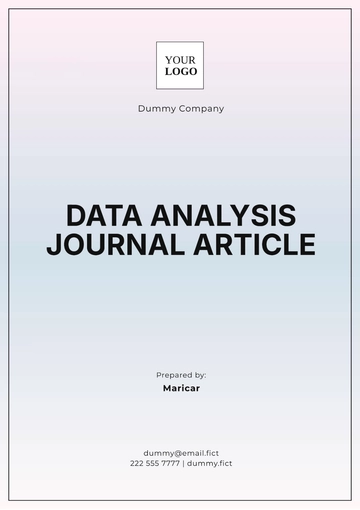Free Meta-Analysis Research Paper

Prepared By: [Your Name]
I. Abstract
This research paper provides an overview of meta-analysis, detailing its purpose, methodology, and findings. Meta-analysis synthesizes results from multiple studies to detect patterns and estimate overall effect size, offering more robust conclusions. The paper discusses the systematic approach and statistical techniques used in meta-analysis, and its significance in evidence-based research, and concludes by highlighting its strengths and limitations, advocating for its rigorous application in academia.
II. Introduction
Meta-analysis is a crucial research tool that synthesizes multiple studies to resolve conflicts, identify trends, and estimate effects, enhancing our understanding of complex issues. This paper explores its process, applications, rigor, and its role in evidence-based practices, highlighting its importance in scientific knowledge and future research.
III. Methodology
A. Formulating a Research Question
A successful meta-analysis begins with a clear, specific research question that is measurable and relevant. This question sets the scope and guides the study, such as assessing an intervention's effectiveness across populations.
B. Literature Search and Selection Criteria
A thorough and systematic literature search is crucial for identifying studies relevant to the research question. This involves:
Databases: Searches are conducted across multiple databases such as PubMed, Scopus, Web of Science, and Google Scholar to ensure a comprehensive collection of studies.
Keywords and Search Terms: Keywords should be carefully selected to capture all relevant studies. For example, a meta-analysis on the efficacy of cognitive-behavioral therapy (CBT) for anxiety might include terms like "CBT," "anxiety," "treatment effectiveness," and "randomized controlled trials."
Inclusion and Exclusion Criteria: Clear criteria must be established to determine which studies will be included in the meta-analysis. Criteria may include:
Study Design: Only randomized controlled trials (RCTs) might be included to ensure high-quality evidence.
Population: Studies involving specific populations (e.g., adults with anxiety disorders) may be included, while others (e.g., studies on children) may be excluded.
Outcome Measures: Only studies measuring specific outcomes (e.g., reduction in anxiety symptoms) may be included.
Publication Date and Language: Restrictions may be applied to include only studies published within a certain timeframe or in specific languages.
C. Data Extraction
Once relevant studies are identified, data is extracted systematically to ensure consistency and accuracy. Key information includes:
Study Characteristics: Details such as the sample size, publication year, study design, and setting provide context for interpreting the results.
Outcome Measures: Specific outcomes relevant to the research question are extracted, such as mean differences, odds ratios, or risk ratios.
Effect Sizes: Quantitative measures of the magnitude of the observed effect (e.g., Cohen's d, Hedges' g) are calculated or extracted from the studies.
Additional Variables: Information on potential moderators (e.g., age, gender, intervention type) and study quality (e.g., risk of bias) is also collected.
D. Statistical Analysis
The statistical analysis phase involves several key steps to aggregate and interpret the data:
Calculation of Effect Sizes and Confidence Intervals: Effect sizes from individual studies are calculated and combined using random-effects or fixed-effects models, depending on the degree of heterogeneity. Confidence intervals are calculated to estimate the precision of the effect size.
Assessment of Heterogeneity: Heterogeneity among studies is assessed using statistical measures such as Cochran's Q test and the I² statistic. High heterogeneity suggests variation in effect sizes that might be due to differences in study populations, interventions, or methodologies.
Publication Bias Evaluation: Techniques such as funnel plots, Egger’s test, and the trim-and-fill method are employed to assess the presence of publication bias, which occurs when studies with positive results are more likely to be published than those with negative or null results.
IV. Results
The results section presents the findings of the meta-analysis in a clear and organized manner:
Descriptive Statistics: This includes a summary of the characteristics of the studies included in the analysis, such as sample sizes, study designs, and key variables.
Forest Plots: These visual representations display the effect sizes of individual studies along with their confidence intervals, providing a clear comparison across studies. The overall effect size is also depicted, summarizing the combined impact of the studies.
Subgroup Analyses and Sensitivity Analyses: These analyses explore whether the results differ across specific subgroups (e.g., age groups, types of interventions) and test the robustness of the findings by varying inclusion criteria or statistical methods.
Study | Sample Size | Effect Size | Confidence Interval |
|---|---|---|---|
Study A | 500 | 0.35 | [0.25, 0.45] |
Study B | 300 | 0.40 | [0.30, 0.50] |
Study C | 450 | 0.30 | [0.20, 0.40] |
Study D | 350 | 0.45 | [0.35, 0.55] |
The table above illustrates the effect sizes and confidence intervals for the studies included in the analysis.
V. Discussion
The discussion interprets the results in the context of the research question and the broader literature:
Implications of the Findings: The findings are discussed in terms of their impact on the field. For example, if the meta-analysis shows a significant effect of an intervention, it may influence clinical practice guidelines or policy decisions.
Comparison with Previous Research: The results are compared with those of previous studies or meta-analyses to identify consistencies or discrepancies. This comparison helps to situate the findings within the broader context of existing research.
Strengths and Limitations: The strengths of the meta-analysis, such as the inclusion of high-quality studies and the use of advanced statistical methods, are highlighted. Limitations, such as potential publication bias, heterogeneity among studies, and limitations in the generalizability of the findings, are also acknowledged.
Recommendations for Future Research: The discussion concludes with suggestions for future research. This may include recommendations for more rigorous study designs, the exploration of specific subgroups, or the investigation of new research questions that arose from the findings.
VI. Conclusion
In summary, meta-analysis is a valuable method for combining research results, offering insights that single studies might miss. When done meticulously, it can support evidence-based practices, influence policy-making, and further scientific progress. Nonetheless, researchers must address challenges like publication bias and study heterogeneity, taking measures to counteract them. Ongoing efforts should aim to improve meta-analytic methods and find new approaches to ensure the reliability and validity of research synthesis.
- 100% Customizable, free editor
- Access 1 Million+ Templates, photo’s & graphics
- Download or share as a template
- Click and replace photos, graphics, text, backgrounds
- Resize, crop, AI write & more
- Access advanced editor
Enhance your systematic reviews with Template.net's Meta-Analysis Research Paper Template. This editable and customizable template guides you through compiling and analyzing multiple studies, ensuring thorough data synthesis and robust conclusions. Editable in our AI Editor Tool, this template streamlines the presentation of your meta-analysis, making it ideal for producing well-structured and credible research papers.





























